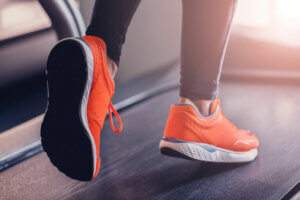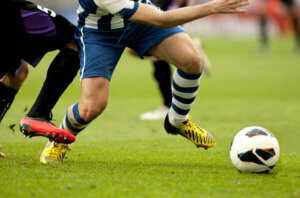4 Types of Shoes That Can Cause Sporting Injuries

There are many different types of sports shoes, but unfortunately, not wearing the right shoes for the sport that you do can significantly increase the risk of an injury. So, let’s take a look at the type of shoes that can cause sporting injuries and why this can happen.
There are two features of the foot which are key to understanding how footwear can cause injuries:
- Plantar arch: the plantar arch is the curved part of the inside of the foot. This is not a solid structure and changes depending on what you’re treading on and how. In a race, for example, the plantar arch is not always the same size or angle. If the plantar arch isn’t able to absorb certain forces or support supination and pronation, then injuries can’t be prevented.
- Pronation-supination: these are two dynamic movements which can be different for different people. Supination is when your foot rolls outwards when moving, putting pressure on the outer edge of your sole. Pronation is when your foot rolls inwards, putting pressure on your planter arch. In reality, the foot should be balanced and simply roll from heel to toe. However, many people have excess supination or pronation, which in turn, puts excessive stress on the muscles, ligaments, and tendons.
By choosing the right footwear for each sport, you could reduce the risk of injury by up to 50 percent. Some of these preventable injuries include tendonitis, plantar fasciitis, and metatarsal fractures.
It’s important to understand that ‘tendonitis’ is a broad term that can be applied to various tendons, such as the Achilles, the posterior tibial, and the popliteal.
What to consider when choosing shoe styles
When buying sports shoes, there are a number of factors that need to be taken into consideration. These include:
- Sporting activity: many manufacturers develop technical footwear which is specially designed for a specific sport. Running on flat ground isn’t the same as running in the mountains, just like standing to hit a golf ball isn’t the same as stopping to shoot on a basketball court.

- Terrain: there are some sports that can be practiced on different playing surfaces, such as tennis, for example. Some tennis courts are soft and some are hard, and some are smoother than others. The sole of the shoe will be essential to avoid any problems.
- Foot shape: everybody has a specific foot shape. The size, the plantar arches, and the arrangement of the toes can vary. Furthermore, people exhibit varying levels of pronation or supination. Most shoes follow standard international size measures, but it’s not the only way that people’s feet can vary. This is why a male shoe might not fit a woman with the same size feet – or even another man for that matter.
Four types of shoes that can cause sporting injuries
So, let’s take a look at the types of shoes that can cause sporting injuries. As we’ve already seen, it can depend on the type of activity and your foot type.
So, using this information, you can identify which shoes you should probably avoid if you don’t want to suffer an injury.
1. No shock-absorption
Any footwear that doesn’t dampen knee movement isn’t recommended for hiking or trekking. These activities need repetitive impact absorption because walks are usually long and the terrain is not always smooth.
2. Smooth soles: shoes that can cause sporting injuries
Smooth soles are not very useful for sports such as soccer. In fact, the grip is rather indispensable to avoid slipping or falling.
In professional soccer, players wear shoes with studs which can often be replaced when they get worn out. Metatarsal microfractures are classic injuries from wearing smooth soles.

3. Oversized
In general, sports shoes should fit well. Loose footwear can increase your risk of stumbling and doesn’t provide enough support, which the body then tries to compensate for. In fact, it’s common for oversized trainers to cause stress injuries in the legs.
4. Shoes that can cause sporting injuries: undersized
Although oversized shoes can be a problem, footwear that’s too tight can be problematic for your skin. It’s likely that you’ll suffer from blisters or hyperkeratosis, which is when the skin becomes thicker due to friction.
In more serious cases, you could develop varicose veins in your legs. This happens because pressure around the foot interrupts the venous return of blood and increases your blood pressure.
Conclusion
In the vast majority of sports, your feet are a pretty fundamental part of the body, so you need to take care of them as much as you can. Choosing the right shoes is really important. So, evaluate what type of foot you have and how this sits with the type of sport you do. If you need help, you can always ask for advice at a local sporting footwear store.
There are many different types of sports shoes, but unfortunately, not wearing the right shoes for the sport that you do can significantly increase the risk of an injury. So, let’s take a look at the type of shoes that can cause sporting injuries and why this can happen.
There are two features of the foot which are key to understanding how footwear can cause injuries:
- Plantar arch: the plantar arch is the curved part of the inside of the foot. This is not a solid structure and changes depending on what you’re treading on and how. In a race, for example, the plantar arch is not always the same size or angle. If the plantar arch isn’t able to absorb certain forces or support supination and pronation, then injuries can’t be prevented.
- Pronation-supination: these are two dynamic movements which can be different for different people. Supination is when your foot rolls outwards when moving, putting pressure on the outer edge of your sole. Pronation is when your foot rolls inwards, putting pressure on your planter arch. In reality, the foot should be balanced and simply roll from heel to toe. However, many people have excess supination or pronation, which in turn, puts excessive stress on the muscles, ligaments, and tendons.
By choosing the right footwear for each sport, you could reduce the risk of injury by up to 50 percent. Some of these preventable injuries include tendonitis, plantar fasciitis, and metatarsal fractures.
It’s important to understand that ‘tendonitis’ is a broad term that can be applied to various tendons, such as the Achilles, the posterior tibial, and the popliteal.
What to consider when choosing shoe styles
When buying sports shoes, there are a number of factors that need to be taken into consideration. These include:
- Sporting activity: many manufacturers develop technical footwear which is specially designed for a specific sport. Running on flat ground isn’t the same as running in the mountains, just like standing to hit a golf ball isn’t the same as stopping to shoot on a basketball court.

- Terrain: there are some sports that can be practiced on different playing surfaces, such as tennis, for example. Some tennis courts are soft and some are hard, and some are smoother than others. The sole of the shoe will be essential to avoid any problems.
- Foot shape: everybody has a specific foot shape. The size, the plantar arches, and the arrangement of the toes can vary. Furthermore, people exhibit varying levels of pronation or supination. Most shoes follow standard international size measures, but it’s not the only way that people’s feet can vary. This is why a male shoe might not fit a woman with the same size feet – or even another man for that matter.
Four types of shoes that can cause sporting injuries
So, let’s take a look at the types of shoes that can cause sporting injuries. As we’ve already seen, it can depend on the type of activity and your foot type.
So, using this information, you can identify which shoes you should probably avoid if you don’t want to suffer an injury.
1. No shock-absorption
Any footwear that doesn’t dampen knee movement isn’t recommended for hiking or trekking. These activities need repetitive impact absorption because walks are usually long and the terrain is not always smooth.
2. Smooth soles: shoes that can cause sporting injuries
Smooth soles are not very useful for sports such as soccer. In fact, the grip is rather indispensable to avoid slipping or falling.
In professional soccer, players wear shoes with studs which can often be replaced when they get worn out. Metatarsal microfractures are classic injuries from wearing smooth soles.

3. Oversized
In general, sports shoes should fit well. Loose footwear can increase your risk of stumbling and doesn’t provide enough support, which the body then tries to compensate for. In fact, it’s common for oversized trainers to cause stress injuries in the legs.
4. Shoes that can cause sporting injuries: undersized
Although oversized shoes can be a problem, footwear that’s too tight can be problematic for your skin. It’s likely that you’ll suffer from blisters or hyperkeratosis, which is when the skin becomes thicker due to friction.
In more serious cases, you could develop varicose veins in your legs. This happens because pressure around the foot interrupts the venous return of blood and increases your blood pressure.
Conclusion
In the vast majority of sports, your feet are a pretty fundamental part of the body, so you need to take care of them as much as you can. Choosing the right shoes is really important. So, evaluate what type of foot you have and how this sits with the type of sport you do. If you need help, you can always ask for advice at a local sporting footwear store.
All cited sources were thoroughly reviewed by our team to ensure their quality, reliability, currency, and validity. The bibliography of this article was considered reliable and of academic or scientific accuracy.
- Mckenzie DC; Clement DB; Taunton JE; (1985). Running shoes, orthotics, and injuries. Sports medicine; sep-oct; 2(5); p. 334-47.
- Hessas, S., et al. “Heel lifts stiffness of sports shoes could influence posture and gait patterns.” Science & Sports 33.2 (2018): e43-e50.
- Reynés Vallverdú, Joan. “¿ Qué importancia tienen las zapatillas deportivas en cuanto al dolor, el impacto y prevención del síndrome de dolor femoropatelar en corredores?.” (2019).
This text is provided for informational purposes only and does not replace consultation with a professional. If in doubt, consult your specialist.








